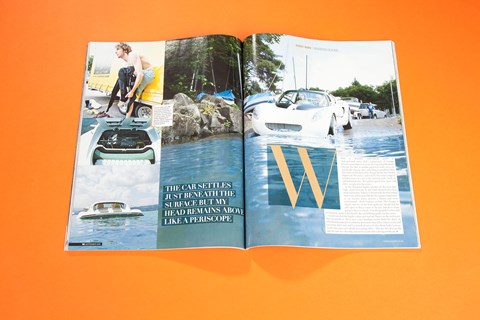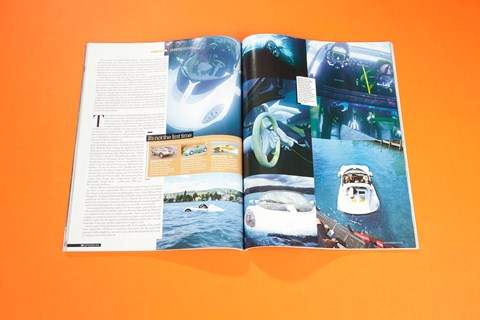► Part car, part boat, part submarine
► CAR drives/floats/steers Rinspeed’s Squba
► A road (or lake?) test in the middle of Lake Zurich
With a slight shudder and a wub-wub-wub noise that’s reminiscent of George Jetson’s spaceship we’re away, driving along the docks towards the lake. A middle-aged man looks on as we aim for the slipway. He’s unloading a speedboat from the trailer on the back of his Range Rover, but I’m not impressed. We pause, and wait by the water’s edge as another man rows out to his moored yacht. Such an old fashioned idea. We gather speed once more and drive straight into the water.
As the Rinspeed Squba splashes in the nose goes light, made buoyant by the foam sprayed into every nook and cranny. It floats! Fabian Grob, the man sitting next to me and responsible for the engineering of this, er, car reaches down, presses a button and we’re transformed — from roadster to boat. The change is simple: louvres in the front grille (or should that be gill) open to direct water to the jets and drive stops going to the rear wheels. Now the propellers whirr and we head out across Lake Zurich, the car bobbing gently on the waves.
I reach out over the Squba’s door and trail my fingers in the cool water that surrounds us. We’re now a few hundred metres from the shore, in what bluntly amounts to a battery-powered Lotus Elise. I know water and electricity don’t mix and I’ve heard all sorts of tales about leaky Lotuses. Grob’s presence isn’t wholly reassuring either — like me, he’s here on the lake because he’s the only one on his team with a diving certificate.
The moment I’ve been dreading arrives — we’re going to submerge this concept car. ‘Please, open your door. Now we dive,’ is Grob’s curt command. My nod is automatic but my gaze back is puzzled, my brain trying make sense of such a counter-intuitive thought. I watch Grob force open his door. The water immediately floods in, welling up around my ankles and finding its way into my wetsuit. It’s freezing and it sends a shiver up my spine to my worried head. This can’t be a good idea.
I look back to my door, then up to the car’s creator Frank Rinderknecht, founder of Rinspeed, who is standing, grinning in a nearby boat. What the heck. I pull the aluminium sliver and push the tiny door as hard as I can. It barely opens under the pressure of the water but the lake soon gushes in through the gap. Within moments it’s a torrent and the pair of us start to float as the cabin fills with water. My weight belt holds me in place while Grob grasps the steering wheel to keep himself inside the car.
The creation of Frank Rinderknecht, the Squba exists for two reasons. The first is a good, old-fashioned publicity stunt to promote Rinspeed, his tuning firm. And if you design and build concept car parts for a living, a diving car (if it works) is a good indication of your talents. The second reason? Passion. ‘Without passion we wouldn’t do what we do,’ says Rinderknecht. ‘There are long hours and heartaches.’ And where do these ideas come from? ‘You have to walk around with open eyes. I take pictures, memorise or make notes. It all goes in a drawer, then I compress it.’

Clearly James Bond also influenced the Squba but, aptly, Rinderknecht is more a fan of Q. For a while he’d been thinking about making the Squba but held off, believing it to be too soon after the Splash, his record-breaking hydrofoil. Whatever next – a flying car? ‘I feel we can do it,’ Rinderknecht calmly states, ‘but we won’t yet. Everyone will say, “Frank, he is crazy. He only does crazy things”. Crazy is a compliment, but I don’t want the Nutty Professor tag. Mad harms the business. If you are always OTT, people don’t take you seriously. We need to make the money that the concepts lose, so we do the unexpected. It’s why all our cars are different. First we make the Terminator, then a love story, Titanic, then Jungle Book. That’s our philosophy.’ Jungle Book – a philosophy? Who says he’s no nutty professor.
CAR has driven a Ferrari through the desert and a Bentley to the Arctic but never a Lotus underwater. This is a new frontier. Lotus was offered the chance to be involved but its philosophies were a little different from Rinspeed’s – no Jungle Book thinking in Norfolk. Undeterred, Rinderknecht purchased an Elise in June 2007. It was stripped and all the spares sold back to the Lotus dealer across the road from Rinspeed’s unassuming pebble-dashed HQ. Rinderknecht is evidently as resourceful as 007 in peril.
Six waterproofed batteries replace the Toyota engine, powering the rear wheels on land and the propellers and jets in the water. But while the electronics are complicated, the rest is as simple as possible. There’s no roof, as a closed cockpit car would need an extra few tonnes to sink it and buoyance tanks to float it again. No, the Squba is just filled with foam, and lots of it. Enough foam that it can carry another 50kg before it starts to sink.
On the road it’ll happily keep up with traffic, as it’s capable of the 75mph Swiss speed limit. Of course it could have been faster, but that wasn’t the goal and, while it might be a zero-emissions vehicle, Rinderknecht isn’t trying to compete with Tesla either.
Driving the Squba on the road is a surreal experience, especially when you’re behind the wheel of a million-euro concept and its creator is driving your Mazda 3 hire car with a photographer hanging out the back. The Squba isn’t too far removed from the donor car, still having that delightfully ultra-responsive, direct steering. Despite weighing 6okg more, it rides well too, thanks to new KW coilover suspension.
And I just can’t believe it’s all still working, even though it emerged from the water just a few hours ago. Bond’s car has been made real, though Bond never had to deal with a wet backside. My exit from Lake Zurich is also not quite as romantic as 007’s departure from the Mediterranean in his Esprit. He looked suave and sophisticated — and dry. I’m soaked through. My hair is matted to my forehead and Grob, frankly, is no Barbara Bach. While onlookers cling to a nearby metal chainlink fence, they are treated to the inglorious site of my 6ft sin frame — in a wetsuit that is far too small for me — unfolding from a recently submerged Lotus Elise. As I stumble from the Squba I know that `Pulman, Ben Pulman’ will never sound cool.

But I have just driven a car on water, and that is cool. On the trip back to shore, Grob explained the controls to me. Finally the Elise’s boulevard-wide sill has a practical use housing the propeller throttle unit that bears the serial number 007. But rather than making me reach across him, Grob suggests we switch places. So, with both propellers running at full chat, we stand up in the Squba, in the middle of Lake Zurich, and squeeze past each other. It’s a new kind of daredevil stunt work.
I settle down into the seat and instantly wind on half a turn of lock to correct our bearing. Nothing. In the water the steering wheel has no affect. Instead you change course with the propellers. The water jets have no use on the surface, only coming into play under the water. You change their angle using the two levers that have replaced the gearstick, and adjust the thrust using the clutch and accelerator pedals. It’s the first car I’ve driven that can move deftly in three dimensions.
Visibility from behind the wheel isn’t great. The water washes over the Squb a’s nose, submerging the high-mounted lights and making the front of the car invisible. Without my glasses and through a windscreen that has water droplets on the outside and inside, I can’t see where I’m going. But if I look to the side I can make out land and just about see other cars motoring along, blissfully unaware that they’re passing a paddling car.
This isn’t the most wondrous thing about the Squba though, and nor is it the actual diving itself. In the waters of Lake Zurich visibility is down to ten metres or less and all I can see is our photographer as we swoop past him. I am, in fact, more drawn to my own hands. Like a child noticing its limbs for the first time I study them, intrigued by this new feeling of weightlessness in the familiar surroundings of the Squba’s cabin. Perhaps it’s the closest I’ll ever get to driving on the moon. Unless Rinderknecht has something brewing.
This isn’t my one over-riding memory of the Squba though, and nor is it Rinderknecht agreeing that his car is unique in that you can urinate in it without penalty. What I will always recall will be free-diving around the Squba once we resurface. Before we wind the windows up and pump out the water I just abandon ship and look around.
The Squba, a car, hanging there suspended in the middle of Lake Zurich, is a mesmerising sight. Like a plane on the ground or a ship in dry dock, it looks so different out of its natural habitat. The suspension is slack and I expend a whole breath just studying the brakes. The matt white paint makes it look like a manatee, and it feels slick and streamlined to touch. It is magical, seductive and mysterious, a strange new type of car. It’s a memory I shall always have, and thankfully one I didn’t take to a watery grave.
The specs: Rinspeed Squba
Cost: £800,000 (est)
Engine: Electric motor with six Seabob lithium-ion batteries, 72bhp @ 4500rpm, 118lb ft@ 1500rpm
Transmission: Rear-wheel drive (on land); two bow jets (under water)
Performance: 5.1sec 0-50mph, 75mph, 0g/km CO2 (on land); 1.8mph under water
Weight: 920kg
Made from: Aluminium/glassfibre
On sale: Make Frank an offer
